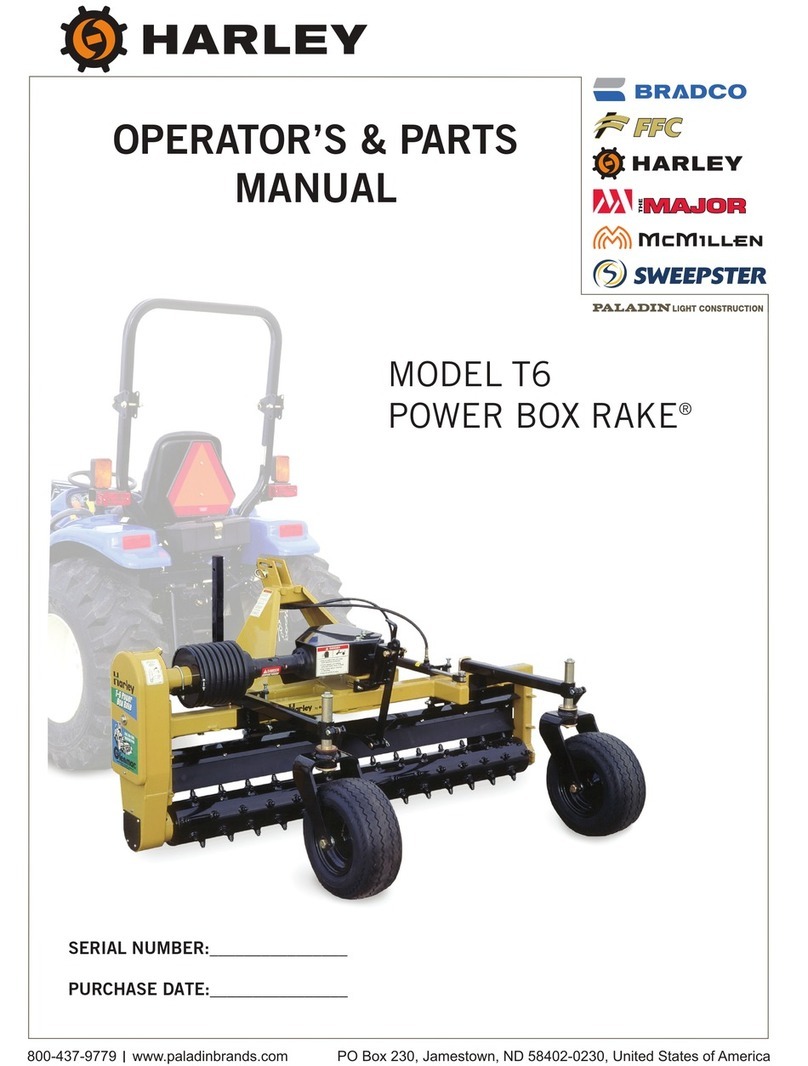
3
SAFETY INSTRUCTIONS
WORK SAFELY - A CAREFUL OPERATOR IS THE BEST INSURANCE AGAINST ACCIDENTS !!
SECTION 1
WARNING
Obey all the safety instructions listed in
this section and throughout this manual.
Failure to obey instructions in this
section could result in death or serious
injury.
BEFORE ATTEMPTING ANY TYPE OF ASSEMBLY,
OPERATION, MAINTENANCE, OR OTHER WORK ON
OR NEAR THIS PRODUCT:
•READ AND COMPLETELY UNDERSTAND THIS
MANUAL.
•READ AND COMPLETELY UNDERSTAND THE
MANUALS PROVIDED WITH YOUR POWER
UNIT, LOADER, and QUICK-ATTACH.
•Read and understand all safety signs on this product
and on your power unit, loader, and quick-attach.
•Know all your controls and know how to quickly stop
all power unit movement, the Preparator®
movement, and the engine in case of an emergency.
•Know and obey all applicable government rules,
O.S.H.A. regulations, local laws and other
professional guidelines for your operation.
•Make sure that anyone who will be assembling,
mounting, maintaining, repairing, removing, and/or
storing this product:
•has been instructed in the safe operation of this
product and of the power unit, loader, and quick-
attach to which this product is attached.
•is physically and mentally capable of the safe
operation of this type of equipment.
•is not under the influence of drugs or alcohol.
•is carefully supervised from a safe distance,
especially if such person is inexperienced.
•wears appropriate protective equipment (i.e.
hardhat, safety glasses, work gloves, protective
shoes, respirator, ear protection, etc.).
•does not wear loose fitting clothing, loose or
uncovered hair, or any accessories (jewelry,
necktie, scarf, wrist watch, etc.) that can catch in
moving parts.
•has annually reviewed all safety instructions.
•Know and follow good work practices when
assembling, mounting, maintaining, repairing,
removing, and storing this product:
•Work on a level surface in a well-lit area.
•Keep the area clean and dry.
•Use properly grounded electrical outlets & tools.
•Use the right tool for the job at hand.
•Make sure that your tools are in good condition
for performing the desired function.
•When using tools, wear the protective
equipment specified by the tool manufacturer.
(i.e. hardhat, safety glasses, work gloves,
protective shoes, etc.)
WHEN YOUR POWER UNIT IS USED DURING ANY
TYPE OF ASSEMBLY, OPERATION, MAINTENANCE,
OR OTHER WORK ON OR NEAR THIS PRODUCT:
•Before leaving the operator’s station or before
beginning any type of work on this product, lower
this product to the ground, apply your power unit’s
parking brake, stop the engine, remove the starter
key, wait for all moving parts to stop, and then
relieve all pressure in the hydraulic lines. Refer to
your power unit’s operator’s manual for instructions
on how to relieve hydraulic pressure in lines.
•Know your loader’s safe lifting and operating
capacity and the weight of this product. See the
specifications in this manual for the weight of this
product and refer to your power unit’s and your
loader’s operator’s manuals for safe operating limits.
Lift capacity may be reduced if using a quick-attach.
•Never allow anyone, except the operator, to be
around the power unit or this product when either is
in motion. Do not startup unless others are clear of
the work area.
•Do not allow riders on this product or the power unit.
•Do not stand or climb on this product when raised.
•Never lift the lowest portion of the attachment plate
higher than 5’-0” above the ground.
•Do not place any part of your body under any part of
this product unless this product is securely resting
on specified blocking or on the ground.
•Do not use blocking made of concrete blocks, logs,
buckets, barrels or any other material that could
suddenly collapse or shift positions. Do not use
wood or steel blocking that shows any signs of
material decay. Do not use blocking that is warped,
twisted, or tapered.
•Never operate controls from the ground. Operate
the controls only from the operator’s station.
•Never leave equipment unattended with the engine
running or with this product raised on the loader.
•Be aware of the added weight and width of this
product. Reduce travel speeds accordingly,
especially when traveling over rough ground.
•Keep this product close to the ground and under
control when transporting.






























